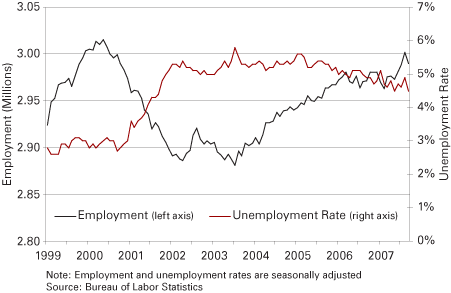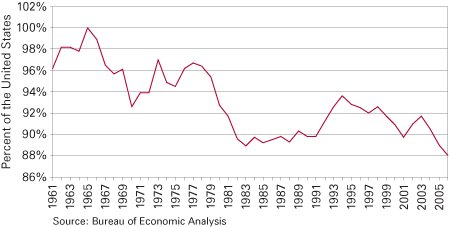Indiana
Director, Indiana Business Research Center, Kelley School of Business, Indiana University
The outlook for Indiana's economy in the year ahead presents a mixed picture, not unlike that of the nation. We should expect more ups than downs, but unsettled economic forces at work beyond our borders make it difficult to hit this moving forecast target. Let's take a closer look at several key indicators of Indiana's economic health.
Jobs: Slowly but Steadily Improving
After a rough start with two months of job losses, Indiana employment in 2007 has resumed the long-term recovery trend that it has generally followed since July 2003, when it reached its lowest point of the decade. By late summer, total payroll jobs had climbed to within just 13,000 of their all-time high, but September's count gave up some of that momentum. Even with that slippage, the state had 18,000 more payroll jobs than it did a year earlier. The general upward employment trend, evident in Figure 1, should keep employment rising by approximately 15,000 more jobs in 2008.
Figure 1
Indiana Nonfarm Payroll Employment and Unemployment Rates

However, not all sectors will share this growth equally. The manufacturing sector in particular is still undergoing a long-term employment decline in our state, just as it is throughout the nation. We expect Indiana will have about 11,000 fewer factory jobs at the end of 2007 than it did at the start, but the rate of shrinkage should abate considerably in 2008, perhaps even leveling off once some large new factory projects come on line. Additionally, Indiana remains the nation's most manufacturing-intensive state: the sector accounts for 18.9 percent of all our payroll jobs.
Meanwhile, construction has grown substantially in 2007, and the sector should add another 4,000 jobs in 2008. Also, we forecast growth in various service sector jobs: health care (+9,000), professional and business services (+5,000), leisure and hospitality (+5,000), and state and local government (+3,000).
Figure 1 shows that the unemployment rate has been slowly declining in Indiana for about three years, and it often has been below the U.S. rate during this period. Though the rate tends to fluctuate from month to month, it's expected to generally hover in the range of 4.5 percent to 4.8 percent through most of 2008.
Income: Still Growing but Losing Ground
Economists' most widely watched income measure is personal income, which includes earnings from employment, income from investments and rental property, payments from governments (e.g., veterans' and social security benefits), among other sources. Indiana's per capita personal income (PCPI) should rise modestly in 2008, growing by less than 2 percent (adjusted for inflation). Though any growth is welcome, this slow rate of growth is well behind most other states. As a result, Indiana's PCPI now stands at 88 percent of the U.S. figure, its lowest relative level in decades (see Figure 2). Thirty-five states have higher per capita incomes; fortunately, Indiana's relatively low PCPI stretches farther due to a low cost of living compared to much of the nation.
Figure 2
Indiana Per Capita Personal Income as a Percent of the United States

State GDP: Also Growing Slowly
Indiana's gross domestic product (GDP), a measure of overall output of the state's economy, was more than $215 billion in 2006, ranking sixteenth among the states. However, after enjoying somewhat stronger growth a few years back, the growth rate has slowed in recent years. Since 2001, Indiana's GDP has grown by 10.6 percent, which surpasses only nine other states.
A key contributor to this trend is the continuing shrinkage of our manufacturing sector. Manufacturing generates 30.2 percent of Indiana's GDP, the highest share in the nation. Generally, when the manufacturing sector is shedding a lot of jobs (as has been the case nationally for several years), states with a lot of manufacturing activity naturally feel the pain more than other states. However, if Indiana's factory sector should experience more growth in 2008 than it has witnessed in recent years, Indiana's GDP should show correspondingly stronger growth too.
Home (Again) in Indiana
Indiana's housing market has generally not experienced the rapid run-up in prices that characterized many parts of the nation during the recent “housing bubble” years. As a result, when that bubble started showing signs of weakness, our housing market was not as adversely affected as in many other states. Nonetheless, Indiana housing is certainly experiencing a slow market, with increasing supply and reduced demand.
Housing permits issued are expected to decline by about 18 percent to 19 percent this year and next, consistent with reports of limited new construction activity. Statewide sales of existing homes should drop about 9 percent in 2007 and 6 percent in 2008. It will likely remain a buyer's market well into the coming year, but by the end of 2008, a good portion of the excess inventory may be absorbed as buyers and sellers adjust to the new credit realities and demand starts picking up. When that happens, construction and home sales should start ticking upward again.
Conclusion
Indiana continues to feel the pinch of retrenchment in the manufacturing sector, but the state shows refreshing signs of growth in several industries and in several geographic areas. All in all, absent a major negative shock to the economy, the state should enjoy a mild breeze in its sails during the coming year.
Also in this Issue…
- Outlook for 2008
- The International Economy
- The U.S. Economy
- Financial Forecast
- Housing
- Indiana Agriculture
- Indiana
- Anderson
- Bloomington
- Columbus
- Evansville
- Fort Wayne
- Gary
- Indianapolis-Carmel
- Kokomo
- Louisville
- Muncie
- Richmond
- South Bend-Mishawaka and Elkhart-Goshen
- Terre Haute
- Return to Table of Contents



